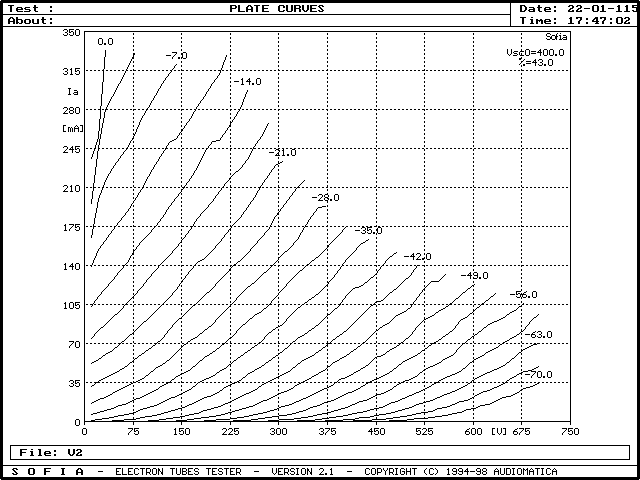Hi,
How should I calculate / determine / guess the driving voltage needed to drive a pair of KT150 tubes in Push Pull (fixed bias)? According to the datasheet the input is 51000 Ohm with fixed bias. Plate voltage is 600 VDC, with 43% UL taps for G2.
https://www.tungsol.com/specs/kt150-tung-sol.pdf
Regards, Gerrit
How should I calculate / determine / guess the driving voltage needed to drive a pair of KT150 tubes in Push Pull (fixed bias)? According to the datasheet the input is 51000 Ohm with fixed bias. Plate voltage is 600 VDC, with 43% UL taps for G2.
https://www.tungsol.com/specs/kt150-tung-sol.pdf
Regards, Gerrit
This datasheet is more complete:
https://frank.pocnet.net/sheets/084/k/KT150.pdf
These are the loadlines for UL 43% connection at 400 V:

So expect to need at least 150Vpp to fully drive them at 600V.
https://frank.pocnet.net/sheets/084/k/KT150.pdf
These are the loadlines for UL 43% connection at 400 V:
So expect to need at least 150Vpp to fully drive them at 600V.
Hi Zintolo,
Thanks for your reply. My current driver delivers around 90 - 95 VRMS. I need to check this again with a 51K load, like a KT150 presents. I guess this should be enough for driving a pair of KT150’s.
RMS Voltage Calculator - Electrical Engineering & Electronics Tools
According to this calculator 150 Vpp will result in 53 VRMS.
How did you calculate 150 Vpp from the graphic?
Regards, Gerrit
Thanks for your reply. My current driver delivers around 90 - 95 VRMS. I need to check this again with a 51K load, like a KT150 presents. I guess this should be enough for driving a pair of KT150’s.
RMS Voltage Calculator - Electrical Engineering & Electronics Tools
According to this calculator 150 Vpp will result in 53 VRMS.
How did you calculate 150 Vpp from the graphic?
Regards, Gerrit
Hi Gerrit,
Well, this afternoon just looking at it, now with the 3/2 power law and the plate dissipation:
The tube has 70 W of plate dissipation, so at 600 V you will bias around 82 mA.
600 V is 1.5 times the shown 400 V, so all voltages need to be increased 1.5 times and currents by anfactor of 1.84 (that is 1.5 ^3/2).
So the same point will be in that plot at around -62 V, that will become -93 V.
So it is 186 Vpp neede to fully drive the push pull into saturation. That is 44 Vrms. Consider to use no more than 47 kOhm as grid leak, it is safer.
I would also consider to use lower voltages, being 600 V the maximum limit in UL.
Well, this afternoon just looking at it, now with the 3/2 power law and the plate dissipation:
The tube has 70 W of plate dissipation, so at 600 V you will bias around 82 mA.
600 V is 1.5 times the shown 400 V, so all voltages need to be increased 1.5 times and currents by anfactor of 1.84 (that is 1.5 ^3/2).
So the same point will be in that plot at around -62 V, that will become -93 V.
So it is 186 Vpp neede to fully drive the push pull into saturation. That is 44 Vrms. Consider to use no more than 47 kOhm as grid leak, it is safer.
I would also consider to use lower voltages, being 600 V the maximum limit in UL.